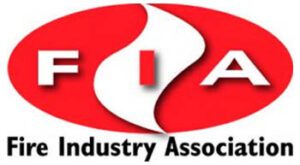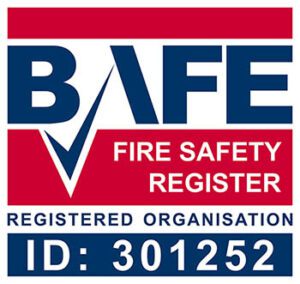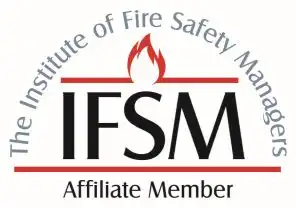All business premises need at least 2 or 3 fire safety signs, but working out which ones you need and where you should put them can be confusing. That’s why we wrote this simple guide.
If you are responsible for any type of commercial premises, you may already know that you need fire safety signs. Fire exit signs are probably the ones we are all most familiar with but there are lots of different categories of fire signage required by the two main pieces of fire safety legislation governing fire safety signs:
The Regulatory Reform (Fire Safety) Order 2005
and
The Health and Safety (Safety Signs and Signals) Regulations 1996
The Regulatory Reform (Fire Safety) Order 2005 – also known as the ‘RRO’ – is the cornerstone of fire safety in the UK and brings together all laws relating to fire safety in one place, not just fire safety signs. The Health and Safety (Safety Signs and Signals) Regulations 1996 apply specifically to safety signage.
We provide a simplified guide to the RRO.
So, what do you need? Well, there are 4 main applications of fire safety signs in the UK:
- A safety sign explaining what to do in case of fire (known as a ‘Fire Action Notice’)
- Safety signs marking fire exit routes, doors and assembly points
- Safety signs showing the location of fire-fighting equipment such as extinguishers
- Warning and Prohibition safety signs such as ‘Danger’ or ‘No Smoking’
Fire safety signs are photo-luminescent so that the glow of the signs will help occupants make their way out of the premises or find fire-fighting equipment if the lighting fails during a fire.
Which signs you require depends on the layout of your premises, the nature of their use, and the fire-fighting equipment you have. If you have a Fire Risk Assessment this document will outline exactly which fire safety signs you need. We explain more about each category of sign below.
1. ‘Fire Action Notice’ – what to do in case of fire
The Fire Action Notice’s purpose is to make sure that anyone working in or visiting your building knows what to do if they discover a fire or if they need to evacuate the building.
These are usually pre-printed signs with spaces to fill in information such as:
- The phone number to call the fire brigade
- The exit to use to leave the building
- Where the assembly point is
- Any additional instructions specific to the building
There are different types of fire action signs so you can pick the one that best suits your premises.
All commercial premises must display a Fire Action Notice. Best practice guidelines recommend that you display a Fire Action Notice next to every Fire Alarm call-point, and at every final exit door, where they are most likely to be seen in the event of fire.
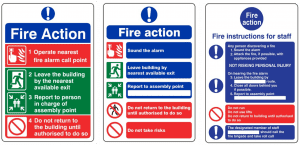
2. Fire Exit Routes, Doors, and Assembly Points
Fire Exit Signs
If your commercial premises are small with a simple layout, you may not need a fire exit sign. Fire exit signs are not a requirement if it is ‘obvious’ where the exit is, for example when there is just one door at the front of a small shop where it is clear that would be the means of escape.
What colour are fire exit signs? They’re typically all green, which is recommended in most international building codes.
For more complex buildings however, fire exit signs are a necessity. What you specifically need comes down to how easily occupants would be able to find their way out of the building in the event of fire, especially if they’re not familiar with the layout.
In some cases you may need a series of directional signs leading occupants along the shortest route to escape. These are familiar to us as green exit signs with arrows indicating which way to go.

Fire Exit Doors
All fire exit doors must carry a ‘Fire door, keep shut’ sign. This is an example of a ‘mandatory’ notice, which simply means that it gives an instruction which must be followed for the building to be safe from fire.
Depending on the type of exits you have, you may also need to provide instructions on how to operate the door, or indicate that a door opens automatically.

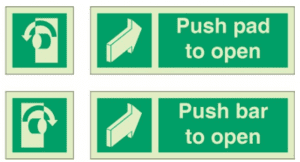
Fire Assembly Points
Your fire assembly point should be far enough away from the building to avoid interference with the fire brigade and danger from falling debris caused by the fire. This means it needs to be clearly signposted.
You may also need to take into consideration the type of occupants who will need to evacuate the building in the event of fire, making sure that the Fire Assembly Point is suitable for the young, old or disabled.
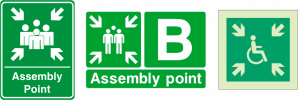
3. Fire equipment signs
In the event of a fire, it’s vital that occupants know where to find fire-fighting equipment, and which equipment they can use, depending on the type of fire.
This is so the fire can be dealt with while it is still in its early stages. 95% of fires tackled with an extinguisher are extinguished within 2 minutes, so being able to locate the right type of fire extinguisher quickly is absolutely critical to the safety of your business.

Fire extinguisher ID signs come in many formats so you can pick the one best suited to the location of your extinguishers. They can be fixed to a wall, or attached to an extinguisher stand.
What does the fire extinguisher sign indicate? It’s there simply to indicate the location of a single or multiple extinguishers nearby. This may need to be additionally highlighted in specific spaces or areas of a building, hence the sings or signs.
You may also need to provide fire safety signs for equipment such as hose reels and dry risers if you have them on your premises.
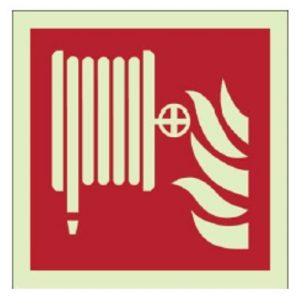
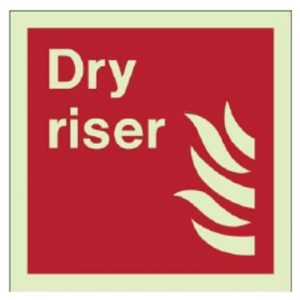
Perhaps most importantly of all, your fire alarm call-points must be clearly sign-posted so that occupants can easily find where to raise the alarm if they spot a fire. Every call-point should have the relevant fire alarm sign, and if you also post Fire Action Notices here, the person raising the alarm will have all the information they need to proceed.
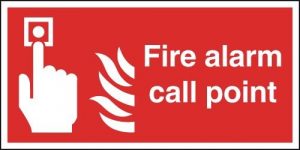
4. ‘Warning’ and ‘Prohibition’ fire safety signs
Warning signs
Warning signs are generally yellow and black, and often (but not always) triangular. They are designed to alert occupants to danger.
In terms of fire safety, you will generally need a fire warning sign when you have flammable substances on the premises, such as gas or oil.
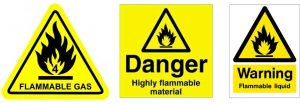
Prohibition signs
Prohibition signs give ‘Do Not…’ style warnings in areas where there is a specific risk of fire. These are frequently used in conjunction with Warning signs, for example to prohibit smoking in an area where there are flammable materials.
Warning signs are usually circular, with a red band around the outside and a diagonal red line across the centre.
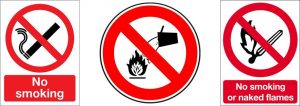
Often warning signs and prohibition signs are combined into one fire safety notice.

Summary
We hope this guide about all of the different categories of fire signage has been useful to you. In summary, if you are responsible for the fire safety of commercial premises, these are the signs that you must have and may need to have.
- Fire Action Notice – mandatory for all premises
- Fire exit signs – needed for all but the smallest & simplest of properties
- Fire Extinguisher ID sign – as extinguishers are mandatory, all premises must have at least one extinguisher ID sign
- Fire alarm call point signs – if you have a conventional or wireless fire alarm, then call point signs are mandatory
- Other fire equipment signs – if you have a hose reel or a dry riser, you will need to signpost them
- Warning & Prohibition signs – if you have an extra risk of fire on your premises you will probably need these
If you would like specific advice on fire safety signs please feel free to get in touch, or take a look at our fire safety sign services here.
Check out more of our fire safety guides below:


